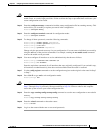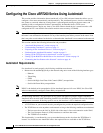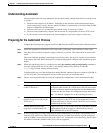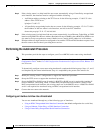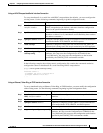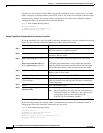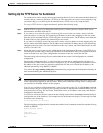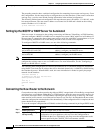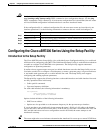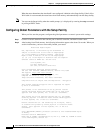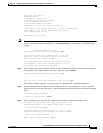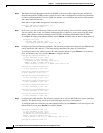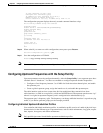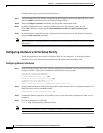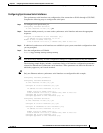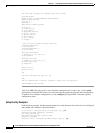
2-17
Cisco uBR7200 Series Universal Broadband Router Software Configuration Guide
OL-2239-03
Chapter2 Configuring the Cable Modem Termination System for the First Time
Configuring the Cisco uBR7200 Series Using the Setup Facility
Caution Verify that the existing and new routers (or access servers) are connected before entering the
copyrunning-config startup-config EXEC command to save configuration changes. Use the ping
EXEC command to verify connectivity. If an incorrect configuration file is downloaded, the new router
will load NVRAM configuration information before it can enter AutoInstall mode.
If the configuration file is a minimal configuration file, the new router comes up, but with only one
interface operational. Use the following commands to connect to the new router and configure it:
Configuring the Cisco uBR7200 Series Using the Setup Facility
Introduction to the Setup Facility
The CiscouBR7200series Setup facility (also called the System Configuration dialog) is a useful and
efficient tool for configuring your CMTS. The Cable Interface Setup Facility is an alternative mechanism
to enable or configure Cisco uBR7200 series parameters. The Setup facility supports automated
configuration of upstream parameters.
In earlier releases, upstream ports were put in a default shut-down state after the Setup facility was run.
You had to use the CLI to configure a fixed frequency or create a spectrum group, assign an interface to
it, and enable each upstream port on a cable interface line card. The Setup facility now supports
configuring and enabling upstream parameters.
The Setup facility supports the following functions so that cable interfaces and cable interface line cards
are fully operational after initial setup:
• Cable-specific commands
• Upstream frequency definition
For each cable interface, the following information is mandatory:
Per upstream:
cable upstream n frequency f
no cable upstream n shutdown
Options include definition of the following information:
• DHCP server address.
• Options are also provided to set downstream frequency for the upconverter per interface.
If you do not plan to use AutoInstall, do not connect the router’s WAN or LAN cable to the channel
service unit (CSU) and data service unit (DSU). If the WAN or LAN cable is connected to the CSU and
DSU and the router does not have a configuration stored in NVRAM, the router attempts to run
AutoInstall at startup.
Tip The router might take several minutes to determine that AutoInstall is not set up to a remote TCP/IP host.
Command Purpose
Step1
telnet existing Establishes a Telnet connection to the existing router.
Step2
telnet newrouter From the existing router, establishes a Telnet connection to the new router.
Step3
enable password Enters privileged EXEC mode.
Step4
setup Enters setup mode to configure the new router.



